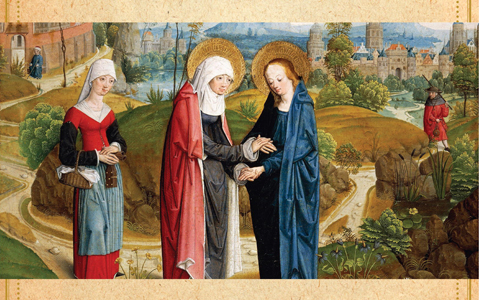
Dear Sister Mary Colombiere,
I have heard of meditation and contemplation and sometimes the words seem to be interchangable. Is there a difference between the two?
Dear Friend,
Let us begin by saying that the basic difference between meditation and contemplation is that meditation is a human mode of prayer whereas contemplation is divinely infused prayer.
In her autobiography, St. Teresa of Avila uses water as an image of various stages of prayer. Meditation corresponds to the First Water. It is an invitation to contemplative prayer and is the characteristic prayer for all who are in this early stage of spiritual growth; in other words those who are in the first three mansions, as St. Teresa would term them. Teresa envisioned the soul as a garden. Since gardens rely on water for life and growth, the person in the first three mansions was the gardener who provided the water. In Teresa’s time the gardener would carry the water in buckets to the garden. In this first level of prayer the gardener provides very much of the labor.
Although meditation uses images, concepts and reasoning, those means which are of the created order to commune with God, it includes nevertheless all forms of prayer in which human effort is quite active. It can offer only a remote knowledge of God. Neither St. Teresa nor St. John of the Cross speak much about methods of prayer but concentrate rather on the fruits of prayer: growth in a virtuous life. For prayer and virtue cannot be separated. Piercing the truths of our faith through reflection on the mysteries of Creation, the Incarnation, and Redemption open us to interior devotion and a longing and yearning for God. The appetite is awakened to experience God’s presence and gives us direction for our lives. When faith enlightens the mind worldly things begin to lose their hold on us. We are drawn away from the “sensual” as we strive to unite our will with the Will of God and we express this through the virtue of our actions.
However, in meditation the method used is intended to lead to a prayer beyond all methods, that is contemplative prayer. Contemplation is often a misunderstood word. It is not a prayer that we can initiate or cause to happen. It is divinely produced and no amount of action on our part can produce or prolong it. To return to Teresa’s image of water infused contemplation begins the Fourth Mansion of the Interior Castle. This is the Second Water in which we still use a bucket but the labor is less intensified since the water comes through an aqueduct and the use of a water wheel. The action here belongs to the Holy Spirit and the work we do is only to dispose ourselves to receive the graces God is giving us.
We have entered into a wordless prayer, an awareness of the Divine Guest within, not through the use of the intellect but through a knowing loving, a deep communion with the Triune God. It is a prayer of quiet calmness in which we drink deeply at the life-giving fount. There are different intensities within this prayer but the way of experiencing and the passion of the experiences will vary among individuals. Our external senses remain free and enable us to carry out our responsibilities and duties even when the interior faculties are captivated by God.
As prayer deepens and we become transformed the Holy Spirit prompts us from within to virtuous actions. In Teresa’s Way of Perfection, Chapter 16 in speaking of contemplation she reminds us that God doesn’t give Himself but to those who give themselves entirely to Him. There is no room here for inordinate self-love.
All of us are called to holiness as Vatican Council II reiterated in Chapter 5 of Lumen Gentium, the Dogmatic Constitution on the Church…
The Lord Jesus, the divine Teacher and Model of all perfection, preached holiness of life to each and everyone of His disciples of every condition. He Himself stands as the author and consumator of this holiness of life: “Be you therefore perfect, even as your heavenly Father is perfect”.
Contemplative prayer, therefore, does not belong to a privileged few. It is a normal common experience of the Christian life open to all. It is God’s to give when and where He wills. Our preparation is to live the Gospel life and to be receptive to the graces God continually gives us – to be watchful and receptive.
Therefore, all the faithful of Christ are invited to strive for the holiness and perfection of their own proper state. Indeed they have an obligation to so strive. Let all then have care that they guide aright their own deepest sentiments of soul. Let neither the use of the things of this world nor attachment to riches, which is against the spirit of evangelical poverty, hinder them in their quest for perfect love. Let them heed the admonition of the Apostle to those who use this world; let them not come to terms with this world; for this world, as we see it, is passing away. (Lumen Gentium Chapter5, #42)
Until next time,
Sister Mary Colombiere, O.C.D
Send your questions for Sister to asksister@integratedcatholiclife.org.
If you liked this article, please share it with your friends and family using the Share and Recommend buttons below and via email. We value your comments and encourage you to leave your thoughts below. Thank you! – The Editors
To learn more about the Carmelite Sisters of the Most Sacred Heart of Los Angeles, read their biography in the left-hand sidebar and visit their website (link provided at the bottom of the bio).
We encourage you to support the work of the sisters with your prayers and through donations and planned giving. Click here to learn more..
If you hear God calling you to the religious life, I encourage you to visit their vocations page. – Deacon Mike
Or for more information, please contact:
Sister Grace Helena, OCD, Vocation Directress
920 East Alhambra Road
Alhambra, California 91801














